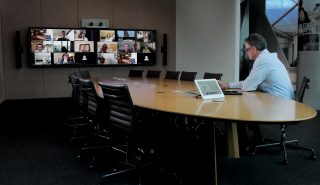By Susan Ferrier, NAB Group Executive, People and Culture.
It’s a new year and the human resources function has never been more important. Following a period of enormous change and disruption, these are the five big trends that I’ve identified for the coming year.
1. 2022 is the year of the employee
Employee turnover is at an all-time high globally, and this is expected to increase in 2022. COVID-19 has triggered ‘the great resignation’ in the United States and elsewhere, with many employees comfortable to quit one job without another one lined up.
In Australia, with borders only recently reopened and a tight labour market, we are all competing for the same talented people, especially among digital talent. Talented people look for organisations where they feel valued, supported and cared for. The employee value proposition, employee experience and company culture are more important than ever.

Offering employees great leaders, meaningful work, opportunities for development and fair remuneration are some of the important basics for every employer to get right.
NAB was awarded the winner of the Best Employer Brand on LinkedIn above 10,001 employees, Australia/New Zealand category at the December 2021 LinkedIn Talent Awards.
We continue to look for more ways to ensure we offer a great place to work, and to attract, retain and engage great people. Visit Careers at NAB to find out more.
2. Sustainability focus
Now more than ever, businesses need to harness the commitment of their people to be ready for the future. Businesses need to attract, develop and retain the leadership, talent and skills required to drive their environmental, social, and governance (ESG) or sustainability strategy.

Many employees have strong views on corporate sustainability practices. In the 2021 Edeleman Trust Barometer, 53 per cent of employees would “recommend an organisation as a place to work based on their climate change beliefs”.
The HR function plays an important part in helping to create and deliver a company’s group strategy, and deliver long-term, sustainable outcomes for stakeholders.
At NAB our strategic ambition is to serve customers well and help our communities prosper.
At the heart of our approach is to make a positive and sustainable impact on the lives of our customers, people, shareholders, communities, and on the environment in which we operate.
3. Hybrid work is here to stay
From early 2020, employees proved their ability to adapt and stay productive while working from home, but we know that personal connection to colleagues through shared time in the office is also important.
Hybrid working is the way of the future. It will look different for everyone. However, spending time in the office supports human connection, collaboration, learning and culture-building.

As we are a relationship bank, most roles at NAB will require face-to-face working, which means a blend of time working from the office and at home.
The COVID-19 situation is still evolving rapidly and we’ll continue to be guided by government and public health experts on how to best return to hybrid working in 2022.
Last year we opened two state-of-the-art corporate head offices in CBDs – one in the heart of Sydney and another in the centre of Melbourne. These offices are designed to be flexible and support hybrid work for years to come. They are also designed to increase collaboration, and to bring NAB’s employees closer to their customers.
4. Virtual team health
While workplaces embrace remote and hybrid working this has implications for teams and how we manage them. Throughout my years in HR, I’ve seen that the top-performing teams have high levels of trust.

Hybrid work can present challenges for building this trust because there’s less time in the office and less casual social connections or face-to-face contact. Meanwhile, remote work provides no opportunity for this face-to-face connection.
Leaders play a critical role here. They must understand their team’s hybrid or remote working circumstances. They can provide networking opportunities for their teams to share their capabilities and to build relationships. This is particularly important with new teams and new team members.
Trust takes time. Role-modelling transparency and accountability, and a willingness to talk about wins and mistakes, gives permission for peers and team members to do the same.
All these steps can help to create a trusting environment and a successful team.
5.Technology and flexibility
The digital acceleration effect of COVID-19 has not slowed down, and there are now so many great tools available to support different ways of working.
NAB has offered flexible working arrangements, including staggered start and finish times, part-time work, and work in flexible locations, for a long time. Technology is now absolutely key to enabling flexible work. We have tools to assist team collaboration and the ability to work anytime and anywhere.
Processes will continue to automate, not only for our customers but out employees. Our online employee self-service HR tool, which is accessible 24/7 is a great example of how technology is improving employee experience where our people can manage their leave, learning and career development.
We’ll continue to see people performing tasks that focus more on the deep thinking, unique, or low-volume work. These are activities that cannot (or should not) be automated.
HR professionals have always been vital to organisations succeeding and employees having great workplaces. We play an important role in many Australians lives, and the global pandemic has highlighted this further.
Here’s to a healthy, happy and successful 2022.




